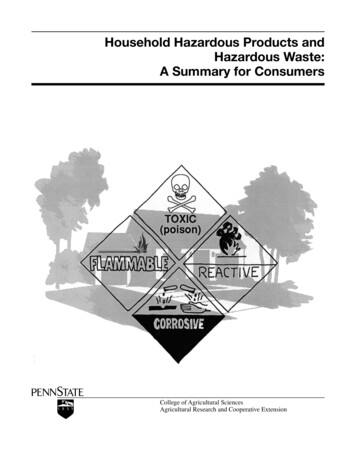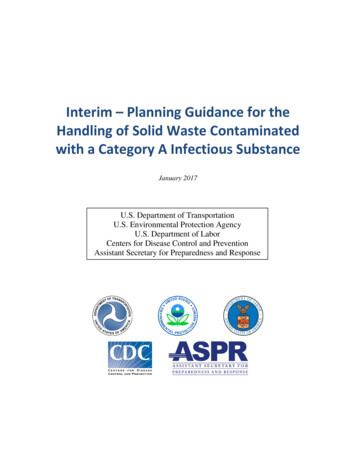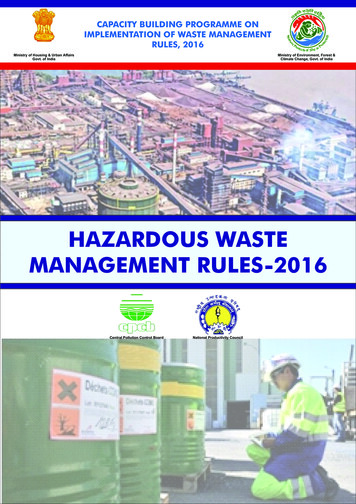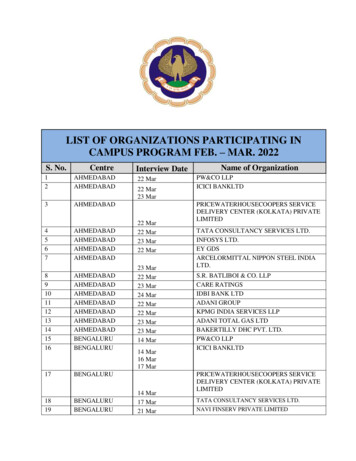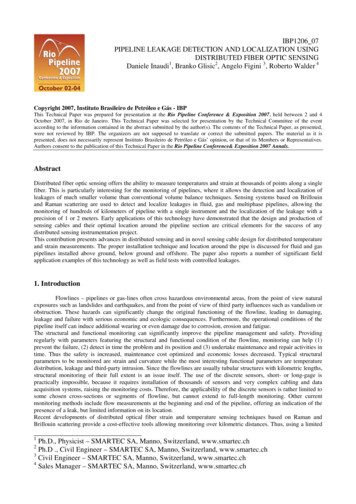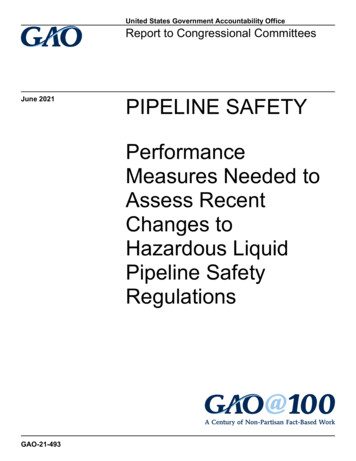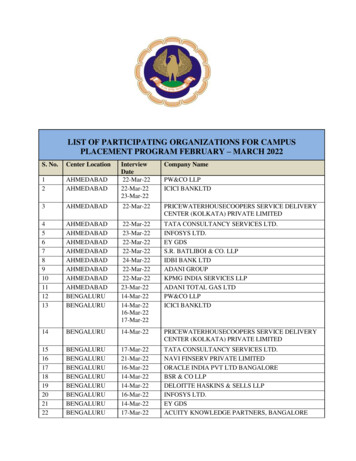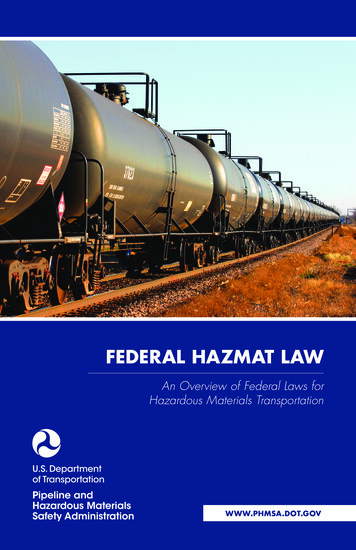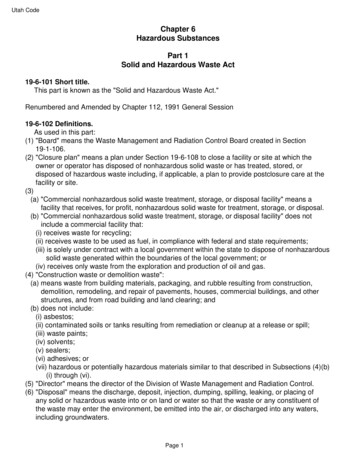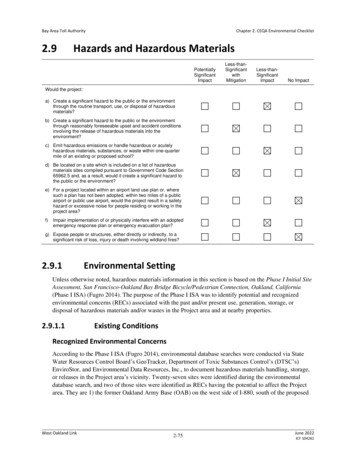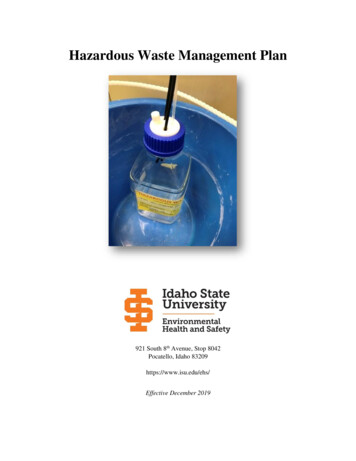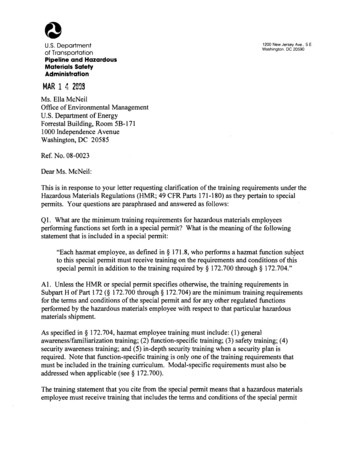
Transcription
U.S. Departmentof TransportationPipeline and HazardousMaterials SafetyAdministration1200 New Jersey Ave. S E.Washington. DC 20590MAR 1 4 2093Ms. Ella McNeilOffice of Environmental ManagementU.S. Department of EnergyForrestal Building, Room 5B- 1711000 Independence AvenueWashington, DC 20585Ref. No. 08-0023Dear Ms. McNeil:This is in response to your letter requesting clarification of the training requirements under theHazardous Materials Regulations (HMR; 49 CFR Parts 171-1 80) as they pertain to specialpermits. Your questions are paraphrased and answered as follows:Q1. What are the minimum training requirements for hazardous materials employeesperforming functions set forth in a special permit? What is the meaning of the followingstatement that is included in a special permit:"Each hazmat employee, as defined in 9 171.8, who performs a hazmat function subjectto this special permit must receive training on the requirements and conditions of thisspecial permit in addition to the training required by 9 172.700 through 172.704."Al. Unless the HMR or special permit specifies otherwise, the training requirements inSubpart H of Part 172 (9 172.700 through 5 172.704) are the minimum training requirementsfor the terms and conditions of the special permit and for any other regulated functionsperformed by the hazardous materials employee with respect to that particular hazardousmaterials shipment.As specified in 9 172.704, hazmat employee training must include: (1) generalawareness/farniliarizationtraining; (2) function-specific training; (3) safety training; (4)security awareness training; and (5) in-depth security training when a security plan isrequired. Note that function-specific training is only one of the training requirements thatmust be included in the training curriculum. Modal-specific requirements must also beaddressed when applicable (see 5 172.700).The training statement that you cite from the special permit means that a hazardous materialsemployee must receive training that includes the terms and conditions of the special permit
and its application to shipments handled by the employee. This training is in addition to thetraining required in accordance with § 9 172.700 through 172.704.42. May we employ a graded approach to the training material and method of training andtesting based on the magnitude of hazard involved, relative importance to safety and securityand complexity of hnctional requirements in the special permit?A2. You may apply such a formula to your training program provided all of the trainingrequirements in Subpart H of Part 172 are met (see A1 and A3).43. Are any of the following methods individually acceptable to meet the HMR trainingrequirements?a. Reading the permit and signing a document stating this was done.b. Attending a formal briefing where the requirements and conditions of the specialpermit are described.c. Participating in hands-on situations where the requirements and conditions of thespecial permit are provided.d. Attending structured classroom training.A3. The methods, as outlined, are not acceptable. As discussed in A 1 and A2, targeting onlythe special permit provisions is not acceptable because it omits the required training elementsin Subpart H of Part 172. Hands-on training or classroom training would be acceptablemethods provided the training curriculum included all required training as specified inSubpart H of Part 172 and provided the special permit training was sufficientlycomprehensive to enable the havnat employee to perform assigned hazmat duties.With respect to meeting the training requirements specific to the special permit, simplyreading or describing the provisions set forth in the special permit may not be sufficient inmost cases to ensure the understanding of the hazmat employee, Moreover, familiarity withthe provisions of the special permit will not ensure that the hazmat employ understands andcan apply HMR requirements needed for the proper performance of most hazmat functions.For example, special permits often reference specific regulatory citations from the HMR.Simply reading or describing the special permit without also, covering the referenced citationswould result in significant gaps in the training. Additionally, such training methods do notnecessarily tie the provisions of the special permit into requirements of the HMR that arenecessary to properly understand and perform certain hazmat hctions.The HMR's training requirements, while specific in the elements, are intentionally broad inthe particulars. The regulations provide the necessary latitude for a hazmat employer todevelop an effective training program and ensure a level of training that is adequate andappropriate for its hazmat employees. The person developing the training program (whetherin-house or contracted) must have sufficient knowledge of the HMR to produce an effectivecurriculum. The Pipeline and Hazardous Materials Safety Administration (PHMSA), Ofice
of Hazardous Materials Initiatives and Training offers training materials designed to helphazmat employers comply with the training requirements. The materials may be ordered bycontacting that office at 2021366-4900 or by accessing PHMSA's website athtt :/lhazn at.dot.g /.Q4. Must the hazmat employer ensure that the hazmat employee is tested on the terms andprovisions of the special permit? If so, must the test be in written form with a passlfailscoring procedure or may it take the form of demonstrating knowledge, or a peer review uponperforming the duties pertaining to the HMR?A4. Yes, the hazmat employer must ensure that the hazmat employee is tested (see5 172.202(d)) on the terms and provisions of the special permit, as well as any otherapplicable HMR requirements, and the requirements in Subpart H, Part 172. With respect tothe type of testing, any form of testing that ensures the employee is able to perform assignedhazmat duties is acceptable.Q5. What is the minimum form of documentation required to show that a hazmat employeehas received training and testing? Must recurrent training documentation be added to thecurrent training files or may it be attached to the shipping file for the applicable shipment?A5. The requirements for documentation are found in 5 172.704(d)(l) through (d)(5).Training records must include: (1) the hazmat employee's name; (2) the most recent trainingcompletion date; (3) a description, copy, or location of the training materials used; (4) thename and address of the person providing the training; and (5) certification that the hazmatemployee has been trained in accordance with HMR requirements.With respect to the location of the training documents, the HMR requires that the documentsbe retained by the hazmat employer, but do not specify a location. However, the h m a temployer must be able to readily produce all of the required training documentation specifiedin 5 172.704(d)(l) through (d)(5) upon request by enforcement personnel or othertransportation personnel.Q6. May a new hazmat employee perform the hnctions specified in a special permit whileunder the direct supervision of a trained hazmat employee provided "special permit training isadministered" to the new employee within 90 days of employment or job function?A6. As provided in 5 172.704(c), a new employee may perform such functions prior tocompletion of training under the direct supervision of a trained hazmat employee.
47. Does the recurrent training requirement, which requires a h m a t employee to havetraining at least once every three years, apply to special permit provisions?A7. Yes.I hope this information is helpful. Please contact this office if you have additional questions.Hattie L. Mitchell, ChiefRegulatory Review and ReinventionOfice of Hazardous Materials SafetySubpart H of Part 172cc: Mr. Ashok Kapoor, DOE
Department of EnergyWashington, DC 20585JAN 2 8 2008Mr. Mr. Edward MazzulloDirector of Hazmat StandardsOffice of Hazardous Materials SafetyPipeline and Hazardous Materials Safety AdministrationU.S. Department of TransportationEast Building, E21-330, PHH-231200 New Jersey Avenue, S.E.Washington, D.C. 20590-0001Dear Mr. Mazzullo:We are requesting clarification of the following training requirement found in the"Compliance" section of each Special Permit issued by the Department ofTransportation (DOT):Each "Hazmat employee" as defined in 171.8, who performs afunctionsubject to this special permit must receive training on the requirementsand conditions of this special permit in addition to the training requiredby 1 72.700 through 172.704.We understand this required training is considered "function-specific" as cited in49 CFR, 172.704(a)(2),and therefore subject to the requirements listed in 49CFR, Part 172, Subpart H, Training. We also understand and acknowledge therehave been many interpretations written by the Office of Hazardous MaterialsSafety (OHMS) stating the employer must determine the training needs of itsHazmat employees based upon the employer's requirements and each employee'sspecific job function. However, based upon various comments received duringDOT compliance reviews within the DOE contractor complex, we are seekingclarification on what the minimum training requirement would be for SpecialPermits. Is a graded approach to the training material, method of training andtesting based on the magnitude of hazard involved, relative importance to safetyand security, and complexity of functional requirements in the Special Permitacceptable?Therefore, we seek clarification in the following areas:Acceptable Training MethodWhat constitutes the minimum requirement for Special Permit training? As statedabove, it is OHMS opinion that the employer must determine training needs of itshazmat employees based upon the employer's requirements and each employee's@Printed with soy ink on recycled paper
specz c job function. DOE contractors employ several methods, including thefollowing:1. Reading of the Special Permit, and signing a form that documents that action.2. Attending a formal briefing, where the requirements and conditions aredescribed.3. Participating in hands on training where the requirements and conditions ofthe Special Permit are provided.4. Attending structured classroom training.Are these methods individually acceptable to meet the training requirements for aSpecial Permit?TestingOnce training has been successfully and compliantly administered, must thehazardous material employer ensure the hazmat employee is tested by appropriatemeans on the training subjects of the Special Permit? If so, must this testing be awritten test with a set passlfail score, or can it take the form of a demonstration ofknowledge or the completion of a peer review when the shipment is prepared fortransport using the Special Permit?RecordkeepingContingent upon the answers above, what is the minimum form of documentationrequired to acknowledge the required trainingltesting has been completed?Must the record of training be added to a record of current training in accordancewith the requirements of 172.704(d), or can it be attached to the shipping file forthe applicable shipment?Initial TrainingMay a new hazmat employee, or one that has not been compliantly trained in therequirements of the Special Permit, perform the functions required in the SpecialPermit while under the direct supervision of a hazmat employee who has beenproperly trained of the requirements of the Special Permit (as long as Specialpermit training is administered to the new employee within 90 days ofemployment or change in job function)?Recurrent TrainingMust the additional training required by the Special Permit be received by theapplicable hazmat employee at least once every 3 years if the Special Permit isutilized for more than that time frame?Again, we ask these questions based upon comments received during the DOTcompliance reviews with the wish to ensure that all hazardous materials
employees are compliantly and efficiently trained to complete their job functionsthroughout the complex.If you need additional information, please contact me at (202) 586-8548, or Mr.Ashok Kapoor at (202) 586-8307, e-mail: ashok.kapoor@,hq.doe.gov.Sincerely,Ella McNeil, Acting fiirectorOffice of Packaging and TransportationOffice of Environnemental Managementcc: D. Chung, EM-60
and conditions of this special permit in addition to the training required by 1 72.700 through 172.704. We understand this required training is considered "function-specific" as cited in 49 CFR, 172.704(a)(2), and therefore subject to the requirements listed in 49 CFR, Part 172, Subpart H, Training. We also understand and acknowledge there
